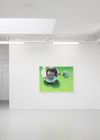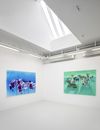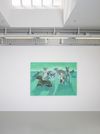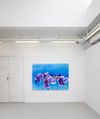Christian Andersen, Frederiksholms Kanal 28A, 1220 Copenhagen K, +45 2537 4101, info@christianandersen.net
Images
Press release
Wang Xiaoqu’s solo exhibition “Alloy Night” constellates instants of nocturnal activities from the artist’s immediate surrounding illuminated by artificial light. These uncanny images aim to capture the individual psyche while stirring established collective phenomena, underscoring the vulnerability, absurdity, and even precarity of life. Comprised of seven recent paintings completed after the pandemic, the exhibition offers dissonant cues and scenarios for the spectators to construct their psyche, only transmutable through visual forms.
Conceiving the work on canvas as a form of writing via visual means, Wang Xiaoqu is keen on depicting familiar figures and scenarios. Her pictorial narrative, woven with sophisticated painterly vocabulary, evokes laughter, shock, and even irony. Previously recognized for portraying middle-aged men with forms and textures that situate them in specific social contexts, Wang’s idiosyncratic image-making unveils individuality and collective conscience otherwise suppressed under the complexity of the Chinese socialist state. Her imageries encouraged viewers to imagine the power and privilege such men embody and the conditions that shape their status quo. Her recent body of work gradually shifts away from the specificity of such a social reality; instead, with a renewed and inventive painterly approach, the artist personifies commonplace subjects such as plants and animals to stretch our imagination beyond specific archetypes and expands their interpretive potential to allegorical dimensions.
The exhibition adopts its title from the phrase, “an alloy of moonlight," describing the gold dom of the capitol in Louise Glück’s poem Love in Moonlight. Like Glück, who pens vulnerability of men and women, nature’s beauty, and desires for cosmic connections, Wang Xiaoqu’s evocation of profound emotions and wonder spans the personal to the collective, aiming to uncover nocturnal energy concealed by the consistent and ubiquitous darkness of the night. Instead of marveling at the various classic symbolism of the moonlight from art history and literature, Wang illuminates her images with artificial light sources, whether in interior spaces or from beaming vehicle headlights, arming her subjects with glimmering shields. As suggested in the title of this exhibition, an alloy is a compounded metal known for rigidity, ultimately attributed to the subject's resilience despite their circumstances.
Due to strict COVID-19 prevention measures, the artist’s daily activities during the pandemic revolved around the vicinity of her Beijing studio. Situated on the capital’s outskirts, where the city blends into its suburbs, migrant workers, the nouveau riche, and foreign expats populate the studio area. In a sense, it is a playground where hybridity and cultural assimilation manifest in more ways than one could count. Western restaurants, equestrian schools, shopping outlets, neighbouring slum villages, and temporary housing fill the artist's everyday experience with stark contrast and uncanny encounters. Even the stray dogs roaming on the street look like crossbreeds between local types and imports.
Rolling into the Night with Excitement preludes the artist’s uncanny encounter where the real and the imaginary begin to blur. A jolly girl in the yogic locust poses in the foreground while another figure entirely collapses atop a yoga ball in the back. Their juxtaposition to a cue stick about to hit the snooker ball throws off the scene into a delirious swing of various forms of leisure and entertainment, indicated by its baize-like or green screen backdrop.
Pictorial ambiguity is also prevalent in Nocturnal Madness, Blackout, and Rumours. The former is the artist’s psychological projection of a lonesome tree into a haunted West Highland White Terrier, rendered indistinguishable from extended self-isolation. While the latter extends from the artist's lasting malaise or even fear of the collective. Her depiction of pansies – a commonplace seasonal plant often used for urban landscaping, are known for their dispensable and decorative character – marks the artist’s use of a metaphorical device. When placed in large numbers, not only does its floral pattern’s semblance to human physiognomy and facial expression begin to emerge, but it also resonates with men’s subconscious crowd psychology - a phenomenon deemed both vulnerable and menacing.
Wang Xiaoqu then elevates such a dichotomous, if not conflicting, psychological complexity through the embodiments of stray dogs. Living an unstable and precarious life, the dog's existence strikes an accord with those living on the edge, including herself, a practicing artist. Often roaming the rummaging on the street in packs at night, when a blinding light shines on them, be it the headlight of vehicles or the gradual sunrise, the singular tonality of the pictures underscores their homogenous nature, only leaving their fuzzy contours and textures visible. Wang Xiaoqu draws attention to the liminal space behind them using a horizon to bifurcate the image, suggesting spatial and temporal transition. Yet, regardless of their idleness recalling the monumentality of Stonehenge or herding forward together in Escape from the Edge of Shadow suggesting a sense of solace, it's the light casting their shadows that defines their nocturnal existence, if not a resilient energy. And by attributing such features to her subjects, Wang Xiaoqu finds resonance with Paul Klee’s famous formulation of “not to render the visible, but to render visible.”
Fiona He


![Rolling into the Night with Excitement [兴奋地滚动着, 进入夜晚], 2024. Acrylic, oil on linen. 120 x 160 cm. Christian Andersen](https://d2p9jye0jgvgyh.cloudfront.net/media/W1siZiIsIjY2NWNiNmJiOTU2NDc5YWE4OGRiMmVkYSJdLFsicCIsInRodW1iIiwiMTAweCIseyJmb3JtYXQiOiJqcGciLCJvdXRwdXRfb3B0aW9ucyI6eyJRIjo4MCwiaW50ZXJsYWNlIjp0cnVlfX1dXQ/CA-123_crop.jpg?sha=97eee33b6ed2a9b2)
![Nocturnal Madness [狂躁的夜], 2024. Acrylic and watercolor on linen. 200 x 140 cm. Christian Andersen](https://d2p9jye0jgvgyh.cloudfront.net/media/W1siZiIsIjY2NWNiNmJhMGFiY2QzOTNiYTQwNzhmYSJdLFsicCIsInRodW1iIiwiMTAweCIseyJmb3JtYXQiOiJqcGciLCJvdXRwdXRfb3B0aW9ucyI6eyJRIjo4MCwiaW50ZXJsYWNlIjp0cnVlfX1dXQ/CA-104.jpg?sha=1abdef5a104b1718)
![Nocturnal Madness [狂躁的夜], 2024. Acrylic and watercolor on linen. 200 x 140 cm. Christian Andersen](https://d2p9jye0jgvgyh.cloudfront.net/media/W1siZiIsIjY2NWNiNmJhOTU2NDc5YWE4OGRiMmVjOCJdLFsicCIsInRodW1iIiwiMTAweCIseyJmb3JtYXQiOiJqcGciLCJvdXRwdXRfb3B0aW9ucyI6eyJRIjo4MCwiaW50ZXJsYWNlIjp0cnVlfX1dXQ/CA-101_crop.jpg?sha=c0cae51597368f0a)
![Cheaters’ Murmur [作弊者], 2024. Acrylic and watercolor on linen. 200 x 140 cm. Christian Andersen](https://d2p9jye0jgvgyh.cloudfront.net/media/W1siZiIsIjY2NWNiNmJiOTU2NDc5YWE4OGRiMmVkYyJdLFsicCIsInRodW1iIiwiMTAweCIseyJmb3JtYXQiOiJqcGciLCJvdXRwdXRfb3B0aW9ucyI6eyJRIjo4MCwiaW50ZXJsYWNlIjp0cnVlfX1dXQ/CA-112_crop.jpg?sha=b2fda616c2361105)



![Blackout [断片], 2024. Acrylic and oil stick on linen. 180 x 120 cm. Christian Andersen](https://d2p9jye0jgvgyh.cloudfront.net/media/W1siZiIsIjY2NWNiNmJiMGFiY2QzOTNiYTQwNzkwNSJdLFsicCIsInRodW1iIiwiMTAweCIseyJmb3JtYXQiOiJqcGciLCJvdXRwdXRfb3B0aW9ucyI6eyJRIjo4MCwiaW50ZXJsYWNlIjp0cnVlfX1dXQ/CA-117_crop.jpg?sha=1a05e0b697d56ea7)
![Escaping the Night [逃离黑夜], 2024. Acrylic and watercolor on linen. 160 x 220 cm. Christian Andersen](https://d2p9jye0jgvgyh.cloudfront.net/media/W1siZiIsIjY2NWNiNmJhMGFiY2QzOTNiYTQwNzhmZiJdLFsicCIsInRodW1iIiwiMTAweCIseyJmb3JtYXQiOiJqcGciLCJvdXRwdXRfb3B0aW9ucyI6eyJRIjo4MCwiaW50ZXJsYWNlIjp0cnVlfX1dXQ/CA-145.jpg?sha=6c9ff433db77944d)
![Escaping the Night [逃离黑夜], 2024. Acrylic and watercolor on linen. 160 x 220 cm. Christian Andersen](https://d2p9jye0jgvgyh.cloudfront.net/media/W1siZiIsIjY2NWNiNmJiOTU2NDc5YWE4OGRiMmVlMiJdLFsicCIsInRodW1iIiwiMTAweCIseyJmb3JtYXQiOiJqcGciLCJvdXRwdXRfb3B0aW9ucyI6eyJRIjo4MCwiaW50ZXJsYWNlIjp0cnVlfX1dXQ/CA-144_crop.jpg?sha=b94b84d53c8aef94)


![The Eternal First Ray of Light [永恒的第一缕光], 2024. Acrylic and watercolor on linen. 145 x 200 cm. Christian Andersen](https://d2p9jye0jgvgyh.cloudfront.net/media/W1siZiIsIjY2NWNiNmJiOTU2NDc5YWE4OGRiMmVkZiJdLFsicCIsInRodW1iIiwiMTAweCIseyJmb3JtYXQiOiJqcGciLCJvdXRwdXRfb3B0aW9ucyI6eyJRIjo4MCwiaW50ZXJsYWNlIjp0cnVlfX1dXQ/CA-134_crop.jpg?sha=527ae7b6845a0fc9)
![Rumours [流言], 2024. Acrylic and watercolor on linen. 200 x 145 cm. Christian Andersen](https://d2p9jye0jgvgyh.cloudfront.net/media/W1siZiIsIjY2NWNiNmJjMGFiY2QzOTNiYTQwNzkwZSJdLFsicCIsInRodW1iIiwiMTAweCIseyJmb3JtYXQiOiJqcGciLCJvdXRwdXRfb3B0aW9ucyI6eyJRIjo4MCwiaW50ZXJsYWNlIjp0cnVlfX1dXQ/CA-139_crop.jpg?sha=11a0a2b8111bdaf6)
